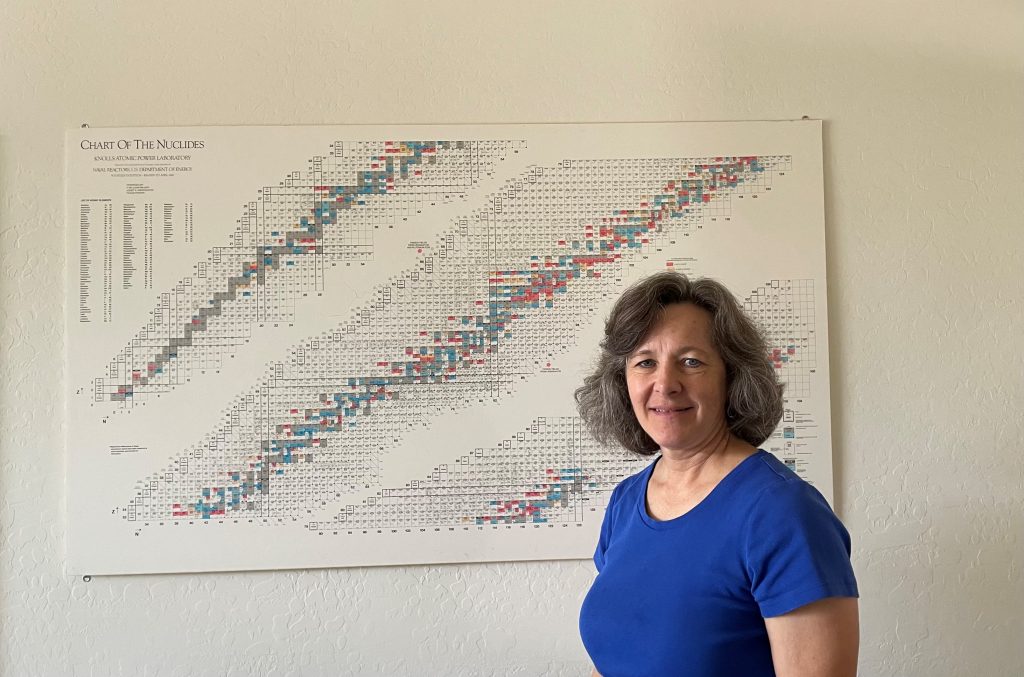Sandia engineer recognized by DOE STEM Rising site for work in nuclear fuel cycle technologies

Sandia chemical engineer Laura Price has been recognized by DOE’s Women @ Energy: STEM Rising website, which honors women in STEM fields throughout the DOE complex.
Laura works on nuclear fuel cycle technologies. She has a bachelor’s and master’s in chemical engineering from Rice University in Houston, Texas.
Laura started her career at Celanese Chemical Company in Corpus Christi, Texas before joining Sandia as a member of the radioactive waste disposal team in 1988. After a move to Florida in 1992, Laura worked as a Sandia subcontractor through the Science Applications International Corporation, during which time her research focused on defining a clear disposal path for radioactive wastes. She was then hired as a Sandia employee in 2007, telecommuting from Arizona, where she still lives.
Throughout her career, Laura’s work has primarily focused on disposal of spent nuclear fuel and high-level waste, specifically assessing the safety of waste disposal over geologic time scales. She worked on the Yucca Mountain project, where she was exposed to a multitude of scientific and technical disciplines involved in safety assessment. Laura’s work on Yucca Mountain gave her an opportunity to learn new things and a newfound appreciation for how complicated assessments can be. When the Yucca Mountain project ended in 2010, Laura’s focus shifted to studying disposal of spent nuclear fuel and high-level waste in generic repositories, expanding her experience with a new and different set of physical processes that could affect repository performance.
Laura was recently interviewed for her feature on the DOE Women @ Energy website.
What inspired you to work in STEM?
I always liked math and science, so when it came time to pick a major, engineering seemed an obvious choice, as it combined both math and science. I liked chemistry, so chemical engineering also seemed like an obvious choice. It didn’t hurt that my uncle was also a chemical engineer in the pharmaceutical industry, pioneering ways to produce life-saving medication and creating industrial standards.
What excites you about your work at DOE?
One of the things that excites me about my work at Sandia is that it supports the use of nuclear energy in the United States, even if indirectly, by finding technical solutions to the problem of waste disposal. Our nation’s infrastructure requires stable, dependable, safe and carbon-free sources of energy — and nuclear energy is one of those sources. Another thing that excites me is that my area of work involves many technical disciplines and has thus provided the opportunity to expand my knowledge base well beyond what I learned in school. I always found nuclear energy to be fascinating, so being able to work in that field, even indirectly, is satisfying.
How can our country engage more women, girls and other underrepresented groups in STEM?
The U.S. Census Bureau’s report on women in STEM seems to indicate that the number of women engaged in STEM jobs has increased over the last 50 years or so. As indicated in this report, as of 2019, women comprised 65% of social scientists, nearly half of the math and life and physical sciences occupations and about 20% of the computer science and engineering work force. These percentages are all higher than they were 50 years ago. In another study, the National Science Foundation’s National Survey of College Graduates in 2015 showed that, in the 29 and younger age group, 56% of those employed in STEM jobs were women. For all workers less than 75 years old, 48% of those employed in STEM jobs were women. It appears the efforts our country has taken toward engaging more women in STEM jobs have been effective.
One underrepresented group consists of those STEM-minded students who go to underperforming schools, where only about 20% of the students are proficient in math and reading. As a country, we can do better at finding new and creative ways for these students to receive a good education and learn basic math, reading, writing and science. One idea for how to do this would be to provide opportunities for people in STEM jobs to mentor and tutor children who are in these situations, thereby
providing role models and promoting STEM proficiency.
Do you have tips you’d recommend for someone looking to enter your field of work?
Learn how to write well. When I was in college, I did not appreciate the importance of not only producing interesting and useful results, but also communicating them to others. I dreaded having to write lab reports, and it wasn’t until later that I realized that while doing good technical work was necessary, it was not enough. Most of what I do is write and contribute to reports, and it is important to be explain to others why the technical work was done, why it is important and what it means.
When you have free time, what are your hobbies?
When I have free time, I like to play the piano, bake, volunteer at my church, ski, travel and stay in touch with our four adult children and their spouses.